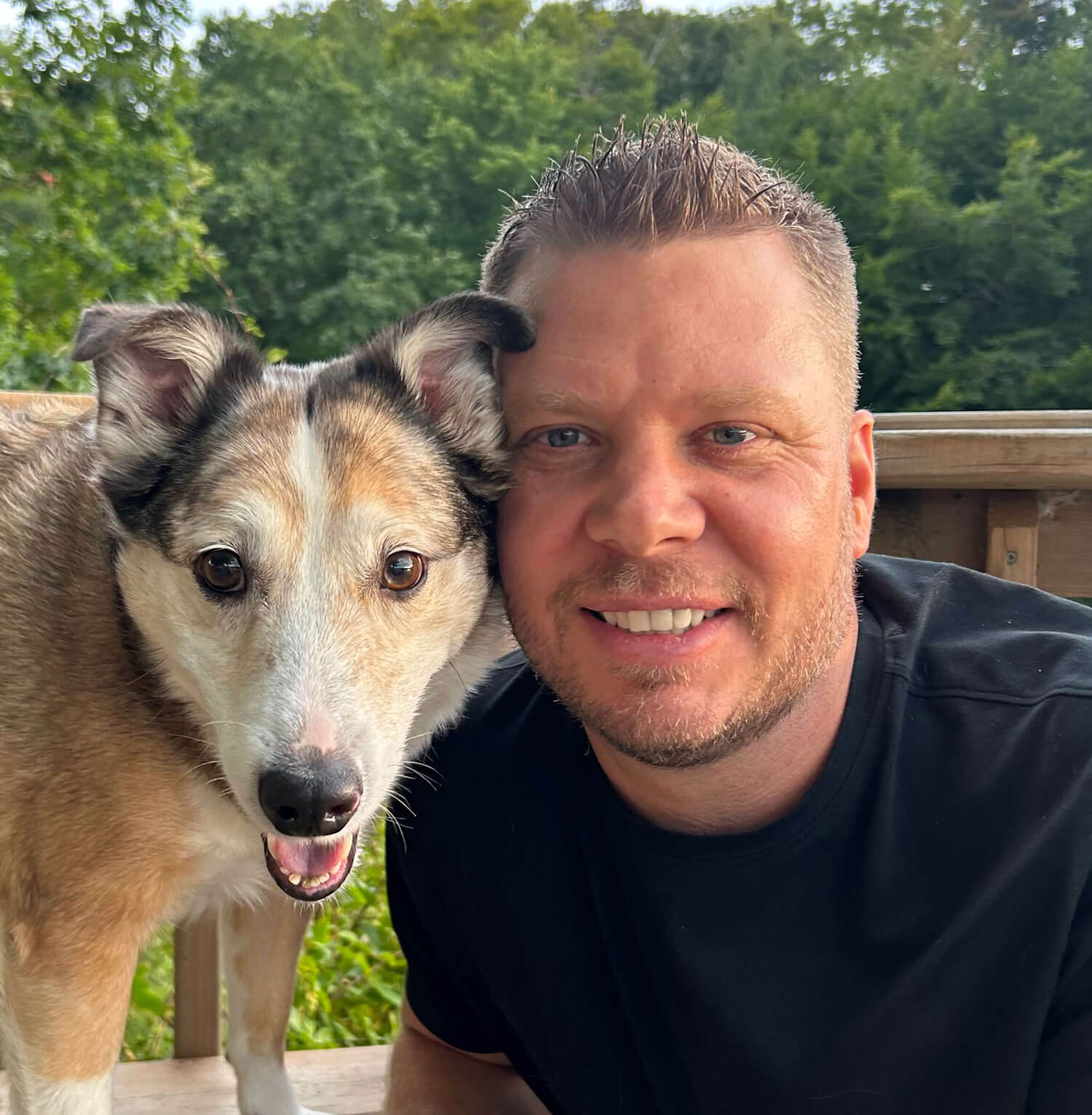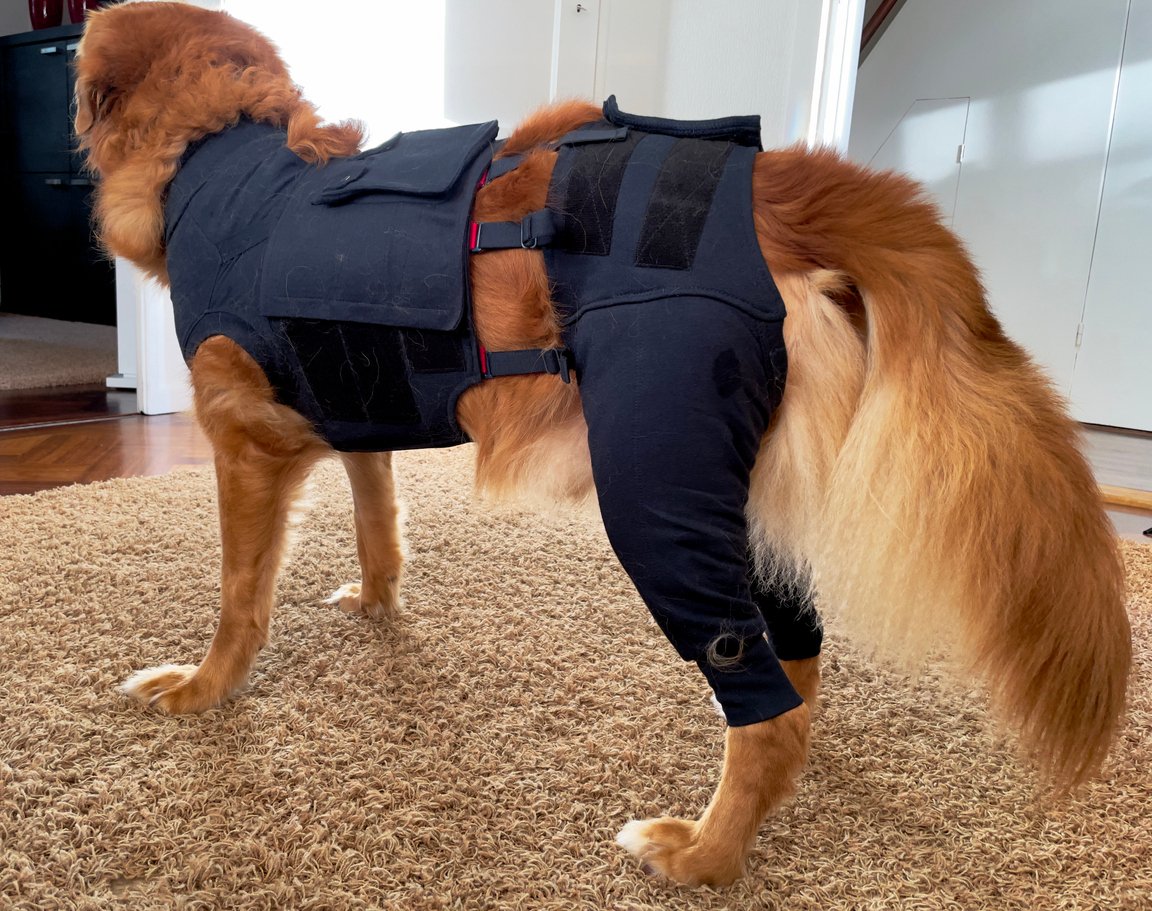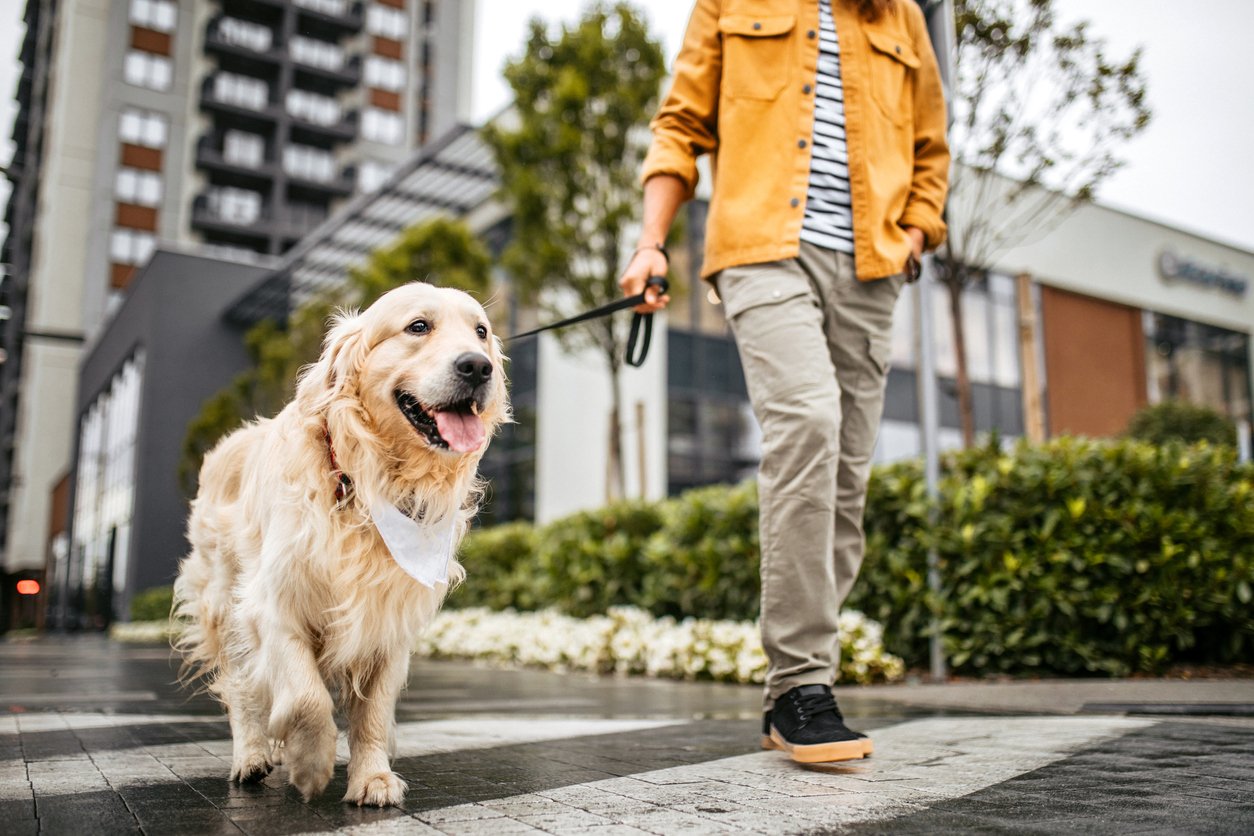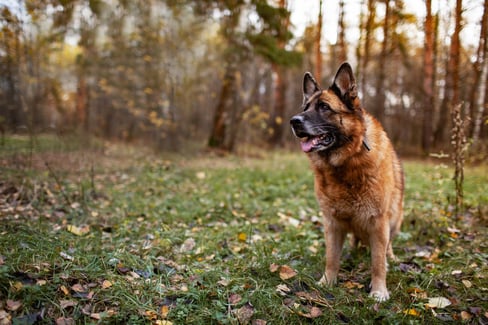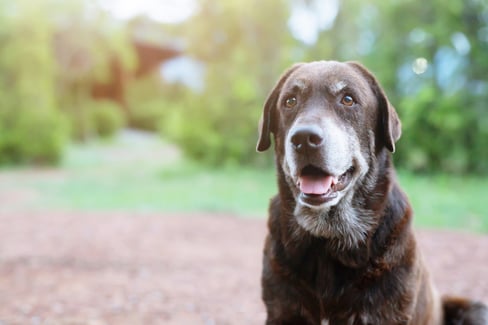Table of Contents
Does your furry friend seem to struggle getting up after a nap or hesitate before bounding up the stairs? While it’s easy to chalk these changes up to laziness or a quirky personality, they could actually be early signs of a condition many dog owners have to face: hip dysplasia.
Despite sounding like a daunting diagnosis, understanding the signs, causes, and preventive measures can empower you to provide your pup with the care they need. Whether you’re raising a playful puppy or caring for an older dog, recognizing the first signs of hip dysplasia is key to ensuring their comfort and well-being. Let’s dive into what to watch for and how you can help your best friend stay active and happy!
Understanding Hip Dysplasia in Dogs
Hip dysplasia in dogs is a common skeletal condition that affects dogs' hip joints. It occurs when the ball and socket of the hip joint do not fit together properly, leading to joint instability and abnormal wear and tear. Over time, this misalignment can cause pain, inflammation, and reduced mobility. In severe cases, it can lead to arthritis in dogs and permanent joint damage.
The condition is developmental, meaning it can start to manifest as a dog grows. Puppies may be born with normal hips but develop the condition due to factors like rapid growth (typical with large or giant breed dogs) or improper nutrition. The severity of hip dysplasia can vary widely, with some dogs showing minimal symptoms while others experience significant discomfort and mobility issues.
Which Dogs Are at Risk?
Certain factors increase the likelihood of a dog developing hip dysplasia:
- Dog Breeds:
Large and giant breeds are particularly prone to hip dysplasia, but smaller and mixed breeds can also be affected. Below is a table based on information from the Orthopedic Foundation for Animals that indicates the estimated percentage of different breeds of dogs that are the most likely to be affected by hip dysplasia:
|
Dog Breed |
Percentage (%) of Dogs Affected by Hip Dysplasia |
|
20.5% |
|
|
19.4 |
|
|
Great Dane |
12.5% |
|
English Bulldog |
73.2% |
|
Labrador Retriever |
11.4% |
- Genetics:
Hip dysplasia is highly heritable. Dogs with a family history of the condition are more likely to develop it. This is one reason why responsible breeding is important, as the more dogs that are bred that have hip dysplasia, the more puppies with the condition will enter the gene pool. It’s important to research and vet breeders before purchasing a puppy from them to ensure that the puppy you receive is as healthy as possible.
Ask a breeder for results of the parents’ health screening tests (which a reputable breeder should have) that evaluates the condition of the hips. PennHIP and the aforementioned Orthopedic Foundation for Animals have testing tools and techniques available that veterinarians often use to test for hip dysplasia.
Of course, some breeds are so prone to hip dysplasia already that it would be impossible to find a puppy that a breeder could guarantee won’t be affected by the condition (this is a guarantee that can’t be given with any dog, but responsible breeding can still lessen instances of the condition overall). Knowing that, adhering to preventative measures and ensuring that your dog gets regular veterinary care and checkups is essential for keeping them happy and healthy throughout their life.
- Environmental Factors:
- Nutrition: Overfeeding or feeding a diet that leads to rapid weight gain can place excessive stress on developing joints.
- Exercise: Excessive exercise or activities that place stress on the hips in young, growing dogs can contribute to the development of hip dysplasia.
- Obesity: Carrying extra weight exacerbates the stress on joints, increasing the likelihood and severity of the condition.
Why Early Detection Matters
Early detection of hip dysplasia is crucial for preventing its progression and improving a dog’s quality of life. Benefits of early diagnosis include:
- Preventing Progression
Early intervention, such as weight management, physical therapy, or supplements, can slow the progression of joint damage. One of the easiest preventative measures you can take with your dog who is at risk of developing hip dysplasia is incorporating joint supplements into their diet. TRI-ACTA contains two types of glucosamine formulated for dogs (each with their own benefits for maximum efficacy), chondroitin sulfate for cartilage repair, and Methylsulfonylmethane (MSM, a natural anti-inflammatory). The combination of these naturally occurring ingredients helps repair, regenerate, and protect cartilage in your dog’s hip joint, lessening the effects of dysplasia.
TRI-ACTA for Pets
A proactive approach for developing and younger adult pets to maintain optimal joint health mobility, minimize inflammation and fend off age-related ailments.

- Improving Outcomes
Dogs diagnosed early may benefit from corrective surgeries, such as juvenile pubic symphysiodesis (abbreviated to JPS, manipulates the growth of the pelvic bone to improve hip joint stability) or double/triple pelvic osteotomy (abbreviated to DPO/TPO respectively, both surgeries involve osteomies of the pelvis to allow for better rotation of the femoral head and to prevent the joint from popping out ), which can improve joint function and reduce pain. Non-surgical interventions like physical therapy and lifestyle adjustments can also significantly enhance mobility and comfort.
- Enhancing Quality of Life
By managing symptoms early, dogs can remain active and enjoy a better quality of life, even as they age. Giving your dog joint supplements, being mindful of their exercise and activity (i.e. choosing activities that don’t put strain on hip joints), and ensuring they eat a controlled and healthy diet are all important in managing symptoms of hip dysplasia in dogs.
First Signs of Hip Dysplasia in Dogs
Before we get started, it’s helpful to understand what is meant by the words “signs” and “symptoms”, as these are two different descriptors that are often used synonymously with each other.
- Signs are objective evidence, something that you can observe. When your dog yelps after landing from catching a ball in the air, that’s an objective sign that they experienced some sort of pain.
- Symptoms are subjective evidence, usually representing the verbal complaints of a patient. Because your dog can’t speak, it can be tougher to distinguish the line between signs and symptoms. But as a dog owner who knows your dog’s behaviour, you’ll be able to pick out times when your pup is acting differently to how they normally would, which could be a symptom that something is off. For example, if your dog usually comes running to the door when you get home from work but suddenly decides to stay laying on their bed instead, that could be a symptom worth noting.
Recognizing the early signs of hip dysplasia is critical for timely intervention. But the initial signs and symptoms can be subtle, making them hard to detect early, but will gradually become more pronounced. First signs of hip dysplasia in dogs can sometimes be detected when the dog is only a few months old, but are usually more obvious when they reach one to two years of age. Confirmation of the condition requires x-rays by a veterinarian.
Key things you can watch out for in your pup’s behaviour and physical signs of potential hip dysplasia include:
|
Category |
Description |
|
Signs vs. Symptoms |
Signs: Observable evidence, such as yelping after landing. Symptoms: Behavioral changes, like reluctance to move or play, noticed by the owner. |
|
Early Recognition |
Subtle signs may appear as early as a few months old; more obvious signs typically appear between 1-2 years. Confirmation requires X-rays. |
|
Changes in Mobility |
|
|
Altered Gait |
|
|
Difficulty with Activities |
|
|
Signs of Discomfort or Pain |
|
|
Physical Changes |
|
Changes in Mobility
Dogs with hip dysplasia often begin to show stiffness, particularly after periods of rest or following vigorous activity. This stiffness may initially be subtle but tends to become more pronounced over time. As the condition progresses, you might notice your dog limping or favoring one hind leg, an indication of discomfort or pain in the affected joint. Reluctance to participate in physical activities such as running, jumping, or climbing stairs is another common sign, as these movements place additional strain on the hips. Gradual slowing during walks or an unwillingness to cover long distances may also signal early mobility issues. These changes in movement often develop progressively, making it essential for owners to monitor their dog’s activity levels and responsiveness to exercise.
Altered Gait
Hip dysplasia frequently causes noticeable changes in a dog’s gait. One of the most recognizable signs is a bunny-hopping motion, where both hind legs move together rather than alternating, as they would in a typical stride. This gait abnormality reflects the dog’s attempt to compensate for joint instability or pain. Additionally, dogs may develop a swaying or waddling motion as they walk, indicative of reduced hip stability. Shortened strides and uneven pacing may also emerge, further evidencing the discomfort or biomechanical difficulties associated with the condition.
Difficulty with Everyday Activities
Dogs with hip dysplasia often face challenges with routine activities that previously posed no issue. Climbing stairs or jumping onto furniture, for example, may become noticeably difficult or avoided entirely. Hesitation or a need for assistance during these tasks can be clear indicators of discomfort. Additionally, dogs may begin lying down or sitting more frequently during play or walks, signaling fatigue or pain. These behavioral changes highlight the impact of the condition on their ability to perform everyday actions comfortably.
Signs of Discomfort or Pain
Discomfort associated with hip dysplasia often manifests through vocalizations such as whining, groaning, or yelping, particularly during movement or when being handled. Dogs may also lick or chew at the affected hip area in an attempt to self-soothe, which can sometimes lead to skin irritation or secondary issues. Restlessness is another common sign, as affected dogs may struggle to find a comfortable resting position, frequently shifting or adjusting their posture. In some cases, a noticeable lethargy or reduced interest in activities they once enjoyed, such as playing or going for walks, may also develop, reflecting the emotional and physical toll of the condition.
Physical Changes
The physical effects of hip dysplasia are often visible as the condition progresses. Muscle atrophy in the hindquarters becomes evident as the dog avoids using their back legs to minimize pain. This reduced use can lead to asymmetrical hips, with one side appearing more protruded than the other due to muscle loss or changes in the joint structure. Advanced cases may also reveal a marked reduction in the dog’s overall activity levels and endurance. To compensate for the reduced use of the hind legs, dogs may shift weight to their front legs, causing strain and visible muscular development in the forelimbs. These changes not only impact the dog’s appearance but also indicate the ongoing progression of the condition and the need for intervention.
What are the First Signs of Hip Dysplasia in Dogs (Puppies)
While hip dysplasia is often more apparent in older dogs, puppies as young as four to six months can exhibit early signs of the condition. Being attentive to these signs can lead to earlier diagnosis and intervention:
- Reluctance to Play:
- Puppies with hip dysplasia may show less enthusiasm for playtime, particularly activities that involve running, jumping, or climbing.
- Abnormal Sitting Posture:
- Affected puppies may sit with their hind legs splayed to the sides, a position sometimes referred to as "frog-leg sitting." While frog-leg sitting isn’t necessarily an indication of hip dysplasia on its own, as some puppies can simply just sit like that naturally, it can be a sign if your dog is exhibiting other signs and symptoms of the condition.
- Reduced Mobility During Growth Spurts:
- Growth spurts can exacerbate symptoms. Puppies may appear stiff or uncomfortable, particularly after exercise or prolonged rest.
- Early Gait Changes:
- A bunny-hopping motion, where the hind legs move together rather than independently, may become noticeable even at a young age.
- Fatigue After Mild Activity:
- Puppies with early hip dysplasia may tire quickly during walks or play sessions, opting to rest more often.
- Sensitivity to Handling:
- A puppy may yelp, pull away, or display discomfort when their hips are touched or manipulated during petting or grooming.
What to Do if You Notice Symptoms
Early intervention and a tailored treatment plan can make a significant difference in the quality of life for dogs with hip dysplasia. Here’s what you need to know if you start noticing symptoms of the condition in your pup:
1. Observe and Document Symptoms
Begin by keeping a detailed record of your dog’s behaviors and physical changes. Take pictures or videos if you can, and note when symptoms occur, their frequency, and any activities that seem to worsen the condition. This information will be invaluable for your veterinarian.
2. Visit a Veterinarian
Schedule a veterinary appointment as soon as possible. Initially, a veterinarian may want to observe your dog walking, so that they can see if anything is amiss in their gait. They will also likely move your dog’s hind legs to check for looseness, signs of pain (vocalizations or trying to pull the limb away quickly), grinding, or reduced range of motion. A thorough physical examination combined with imaging, such as X-rays, will help confirm a diagnosis of hip dysplasia and assess its severity.
3. What are the First Signs of Hip Dysplasia in Dogs Treatment
- Medications: Nonsteroidal anti-inflammatory drugs (NSAIDs) can help manage pain and reduce inflammation. However, long-term use of NSAIDs can pose risks such as liver and kidney damage.
- Joint Supplements: Products like TRI-ACTA H.A. (the H.A. is there for the inclusion of hyaluronic acid, which helps increase joint lubrication and therefore mobility in addition to the regular ingredients of TRI-ACTA) are designed to support joint health and repair. These supplements can be used alongside NSAIDs to enhance treatment efficacy and may eventually allow for a reduced dosage of NSAIDs or eliminate their need entirely. By improving joint lubrication and cartilage health, TRI-ACTA helps slow the progression of hip dysplasia while minimizing the risks associated with prolonged NSAID use.
- Weight Management: Maintaining a healthy weight reduces stress on the joints, helping to alleviate pain and prevent further damage.
- Surgical Interventions: In severe cases, surgical options like total hip replacement or femoral head osteotomy as mentioned above may be recommended to restore mobility and reduce pain.
Preventing and Managing Hip Dysplasia
Even for dogs that are prone to the condition, once you recognize the first signs of hip dysplasia in dogs, it’s important to begin preventative measures to give them the best quality of life possible. Dogs with hip dysplasia can comfortably live for a long time with the condition as long as they have the right support from their owners.
1. Preventive Care
- Proper nutrition plays a crucial role in preventing hip dysplasia. Feeding your dog a balanced diet that supports slow, steady growth in puppies can reduce stress on developing joints.
- Regular exercise is essential, but it should be age-appropriate and not overly strenuous, especially for breeds predisposed to hip dysplasia.
- Weight control is critical in minimizing stress on the hips. Maintaining an ideal body weight reduces the risk of joint damage and pain.
- Joint supplements, such as TRI-ACTA, can be introduced early in a dog’s life to promote joint health. Even for dogs genetically predisposed to hip dysplasia, preventive measures can significantly delay or reduce the severity of the condition.
2. At-Home Care for Dogs with Hip Dysplasia
- Provide supportive bedding to reduce pressure on joints and enhance comfort during rest. Orthopedic dog beds are a good choice as they are formulated with the right materials and construction to provide comfortable support for your dog’s hips.
- Install ramps or low steps to help your dog navigate areas they frequent without straining their hips. Common places to put ramps are beds, couches, and decks or patios.
- Ensure your dog's living environment is free from slippery surfaces to prevent falls and further joint injuries. Adding carpets or area rugs to flooring helps give your dog grip as it walks, preventing odd contortions of their hips and legs that could aggravate hip dysplasia.
3. Long-Term Management
- Physical therapy can improve muscle strength and joint stability, reducing pain and enhancing mobility.
- Hydrotherapy, or water-based exercise, provides a low-impact way to maintain muscle tone and joint flexibility without adding stress to the hips.
- Adjusting exercise activities and playtime to accommodate hip dysplasia is important. Activities like fetch with a frisbee or ball encourage your dog to contort their bodies to retrieve the object, which can aggravate hip dysplasia. Sticking to activities like walks, swimming, short bursts of running, or even tailored agility courses can help lessen the load on their hips while at the same time giving them the exercise they need.
- Regular veterinary check-ups are essential to monitor the progression of hip dysplasia and adjust treatment plans as needed.
Conclusion
While hip dysplasia might sound overwhelming, the good news is that early detection and proactive management can make a world of difference for your dog. With proper nutrition, tailored exercise routines, joint supplements like TRI-ACTA, and the guidance of your veterinarian, your furry friend can continue to enjoy life to the fullest. By staying observant and taking preventive steps, you’ll not only support your dog’s physical health but also strengthen the bond you share. Remember, your care and attention are the greatest gifts you can give your dog. Together, you can tackle hip dysplasia and ensure they lead a comfortable, joyful life!
Ready to start your dog on joint supplements?
Purchase TRI-ACTA online, or learn where to buy at a store near you.
TRI-ACTA H.A. for Pets
Our maximum strength formula is optimally designed to accelerate the formation of cartilage, minimize inflammation, expedite the healing process, and improve joint conditions.

Newsletter Signup
Subscribe to our newsletter to receive the latest news and exclusive offers.
.jpg?height=2000&name=Cliick_Integricare-DISPLAY-REVISEDV2%20(1).jpg)
Proactive & Therapeutic Joint Supplements
When given daily, Integricare joint supplements recover bone and joint injuries faster and help prevent mobility injuries from happening in the first place.


